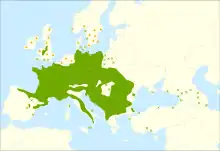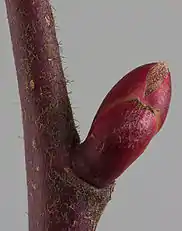Tilia platyphyllos
Tilia platyphyllos (large-leaved lime or large-leaved linden) is a species of flowering plant in the family Malvaceae (Tiliaceae). It is a deciduous tree, native to much of Europe, including locally in southwestern Great Britain, growing on lime-rich soils. The common names largeleaf linden[1] and large-leaved linden are in standard use throughout the English-speaking world except in the British Isles, where it is known as large-leaved lime.[2] The name "lime", possibly a corruption of "line" originally from "lind", has been in use for centuries and also attaches to other species of Tilia.[3] It is not, however, closely related to the lime fruit tree, a species of citrus.
| Tilia platyphyllos | |
|---|---|
.jpg.webp) | |
| Scientific classification | |
| Kingdom: | Plantae |
| Clade: | Tracheophytes |
| Clade: | Angiosperms |
| Clade: | Eudicots |
| Clade: | Rosids |
| Order: | Malvales |
| Family: | Malvaceae |
| Genus: | Tilia |
| Species: | T. platyphyllos |
| Binomial name | |
| Tilia platyphyllos | |
 | |
| Distribution map | |
| Synonyms | |
|
Tilia grandifolia Ehrh. | |
The specific epithet platyphyllos means "with broad leaves".[4]
Description
Tilia platyphyllos is a narrowly domed tree with a moderate growth rate, and can eventually attain a height of 40 m. The reddish-brown young stems later develop dark grey bark with fine fissures and furrows. The branches spread upwards at wide angles. The twigs are reddish-green and slightly pubescent.[5] The foliage consists of simple, alternately arranged leaves. As indicated by its common name, this tree has larger leaves than the related Tilia cordata (small-leaved lime), 6 to 9 cm (exceptionally 15 cm). They are ovate to cordate, mid to dark green above and below, with white downy hair on the underside, particularly along the veins, tapering into a mucronate tip. The margin is sharply serrate, and the base cordate; the venation is pinnate along a midrib. The pubescent petiole is usually 3–4 cm long, but can vary between 1.5–5 cm. The autumn foliage is yellow-green to yellow.
The small, fragrant, yellowish-white flowers are arranged in drooping, cymose clusters in groups of 3 to 4. Their whitish-green, leaf-like bracts have an oblong-obovate shape. The geniculate peduncles are between 1.5–3 cm long. The hermaphroditic flowers have 5 sepals and 5 tepals, numerous stamens, but no staminodes. The superior ovary is 2–10 locular with one smooth style. The flowers are pollinated by butts. The fruit is a fat, round, tomentose, cream-colored nutlet with a diameter of 1 cm or less. It has a woody shell with 3–5 ridges.
.jpg.webp) leaves
leaves flowers
flowers_JPG1R.jpg.webp) roots
roots vegetative bud starting to open
vegetative bud starting to open
Cultivation
Tilia platyphyllos is widely planted throughout the temperate world as an ornamental tree in parks and city streets. Numerous cultivars are available, including 'Aurea', (golden leafed), 'Fastigiata', 'Laciniata' (seemingly torn leaves), 'Örebro' (columnar), 'Princes Street' (narrow crown), 'Rubra' (red twigged), 'Tortuosa' (twisted branches), and 'Tiltstone Filigree' (upswept branches).[6]
The cultivar 'Rubra' has gained the Royal Horticultural Society's Award of Garden Merit.[7][8]
Hybrids
Tilia platyphyllos readily hybridises with Tilia cordata, the hybrid being the Common Lime T. × europaea (syn. T. × vulgaris).
Fossil record
Fossils of Tilia platyphyllos have been described from the fossil flora of Kızılcahamam district in Turkey, which is of early Pliocene age.[9]
Use
Tilia wood is used for carving, and almost all parts of the tree can be used for fodder, ropes or firewood. Bast and honey, which were historically the main products of Tilia, may have been an important factor in the spread of the species and its status as a typical agroforestry tree in the Middle Ages. Tilia spp. are also important for amenity use, shelterbelts and game plantings in the open landscape, in urban areas and recreational forestry.[10]
Traditional medicine
The plant also contains tannins that can act as an astringent.[11] The wood is burned to charcoal and ingested for intestinal disorders and used topically for edema or infection, such as cellulitis or of the lower leg.[11]
Famous trees
- 300-year-old T. platyphyllos at Schloss Linderhof Bavaria – known in German as the "Koenigslinde".[12]
- 350-year-old T. platyphyllos at Schloss Holzheim Hesse – known as the "Landgrave's lime".
- 700-year-old T. platyphyllos at Bojnice Castle, Slovakia – known in Slovak as "Bojnická lipa" ("the Bojnice Linden") or "Lipa kráľa Mateja" ("King Matej's Linden").[13]
References
- "Tilia platyphyllos". Natural Resources Conservation Service PLANTS Database. USDA. Retrieved 10 December 2015.
- RHS A-Z encyclopedia of garden plants. United Kingdom: Dorling Kindersley. 2008. p. 1136. ISBN 1405332964.
- Shorter Oxford English dictionary, 6th ed. United Kingdom: Oxford University Press. 2007. p. 3804. ISBN 0199206872.
- Harrison, Lorraine (2012). RHS Latin for gardeners. United Kingdom: Mitchell Beazley. p. 224. ISBN 9781845337315.
- Martin, W.K. 1965. The Concise British Flora in Colour. Ebury Press
- White, J. & More, D. (2003). Trees of Britain & Northern Europe. Cassell's, London. ISBN 0-304-36192-5.
- "RHS Plant Selector – Tilia platyphyllos 'Rubra'". Retrieved 6 June 2013.
- "AGM Plants - Ornamental" (PDF). Royal Horticultural Society. July 2017. p. 102. Retrieved 23 December 2018.
- Kasaplıgil, B.-(1975): Pliocene Flora of Güvem village near Ankara, Turkey, Abstracts of the Papers Presented at the XII International Botanical Congress, Akademika Nauk SSSR, 1: 115, Leningrad
- Jensen, J.S. (2003). "Lime - Tilia spp" (PDF). EUFORGEN Technical guidelines for genetic conservation and use: 6 p. Archived from the original (PDF) on 2018-12-04.
- Bradley P, ed. British Herbal Compendium. Vol. I. Dorset (Great Britain): British herbal Medicine Association; 1624: 142–144
- McIntosh, Christopher (15 September 2012). The Swan King: Ludwig II of Bavaria. I.B.Tauris. p. 193. ISBN 978-1-84885-847-3.
- "Large-leaved lime near the castle". Monumental trees. Retrieved 17 February 2014.
| Wikimedia Commons has media related to Tilia platyphyllos. |
External links
- Tilia platyphyllos - distribution map, genetic conservation units and related resources. European Forest Genetic Resources Programme (EUFORGEN)
